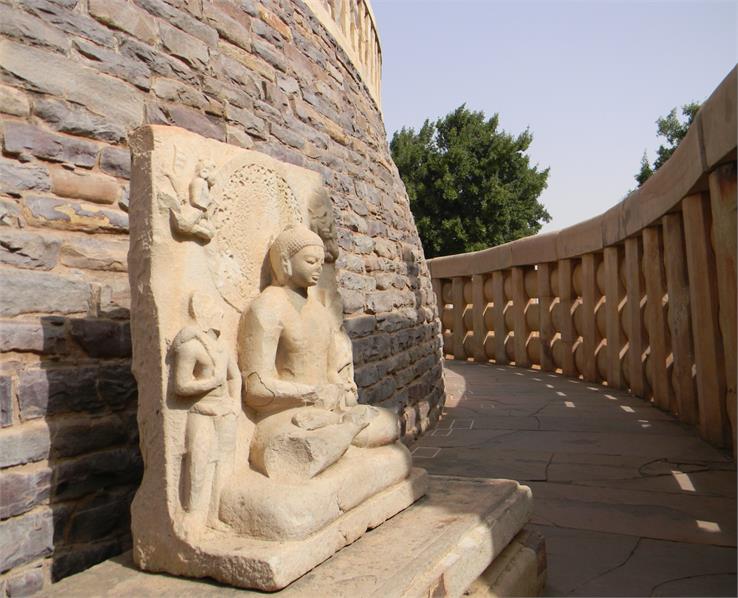Explore The Buddhist Monuments Heritage At Sanchi!

Nestled amidst the serene landscape of the Indian state of Madhya Pradesh lies the ancient town of Sanchi, home to one of the world's most significant and well-preserved Buddhist monuments. Sanchi, often referred to as the "Stupa City," is an architectural marvel that bears testimony to the rich Buddhist heritage of India.
Also Read: UNESCO World Heritage Sites of India
Buddhist Monuments At Sanchi Are Symbols of Peace and Enlightenment | A Visual Journey Through Buddhist History
Here are the full details of the Buddhist Monuments at Sanchi, their history, significance, and the spiritual essence they hold.
1. Historical Background
The history of the Buddhist Monuments at Sanchi dates back to the 3rd century BCE, during the reign of Emperor Ashoka. Ashoka's unwavering commitment to Buddhism after the Kalinga War led to the construction of these monuments. Sanchi served as a major Buddhist center during that period and played a pivotal role in spreading the teachings of Buddhism across India and beyond.
Also Read: Nalanda Mahavihara The World Heritage Site
2. The Four Stupas
There are four stupas in Sanchi. Each stupa is known for its unique characteristics. Here is the details of each stupa given below:
1. Stupa One: The Great Stupa
The Great Stupa, also known as Stupa 1, is the most iconic structure at Sanchi. It stands as a symbol of Buddhism's architectural and spiritual magnificence. This massive hemispherical dome, constructed using bricks and stones, reaches a height of 54 feet and has a diameter of 120 feet. The four gateways that adorn the Stupa are adorned with intricately carved scenes from the life of the Buddha and Jataka tales. These gateways are considered masterpieces of Buddhist art and provide invaluable insights into the life and teachings of Siddhartha Gautama.
2. Stupa Two
This stupa is slightly smaller than the Great Stupa but equally remarkable. It contains relics of Buddhist monks and stands as a testament to the reverence for Buddhism in ancient India.
Also Read: Taj Mahal The World Heritage Site In India
3. Stupa Three
Stupa 3 is known for its finely carved decorative elements and is a testament to the artistic prowess of ancient Indian craftsmen. It features scenes from the life of the Buddha and stories from his previous lives.
4. Stupa Four
Smaller in size compared to the other stupas, Stupa 4 is the least visited but still holds historical and religious significance. It is believed to have been constructed during the later period of Buddhist influence in India.
4. The Ashoka Pillar
The Ashoka Pillar at Sanchi is another highlight of this historical site. This monolithic pillar, made of sandstone, is adorned with four lions standing back to back, symbolizing Ashoka's commitment to non-violence. The Ashoka Pillar at Sanchi is also inscribed with inscriptions that provide insights into Ashoka's support for Buddhism and his efforts to spread the Dharma.
5. The Gupta Temple
In addition to stupas and pillars, Sanchi is also home to the Gupta Temple, a fine example of early Hindu architecture. This temple, dedicated to Lord Vishnu, demonstrates the coexistence of Buddhism and Hinduism in ancient India.
Also Read: The Architectural Work of Le Corbusier
6. Significance and UNESCO World Heritage Site
In recognition of its historical and cultural importance, the Buddhist Monuments at Sanchi were designated as a UNESCO World Heritage Site in 1989. They serve as a symbol of the rich Buddhist heritage that once thrived in India and continue attracting scholars, archaeologists, and pilgrims worldwide.
The Buddhist Monuments at Sanchi are a testament to India's rich spiritual and architectural heritage. They provide a window to a bygone era when Buddhism flourished in India and beyond. The intricately carved gateways, massive stupas, and the Ashoka Pillar not only showcase the artistic brilliance of ancient Indian craftsmen but also offer valuable insights into the life and teachings of the Buddha. A visit to Sanchi is not just a journey through history; it is a spiritual and cultural pilgrimage that leaves a lasting impression on all who have the privilege of experiencing its enigmatic beauty.












